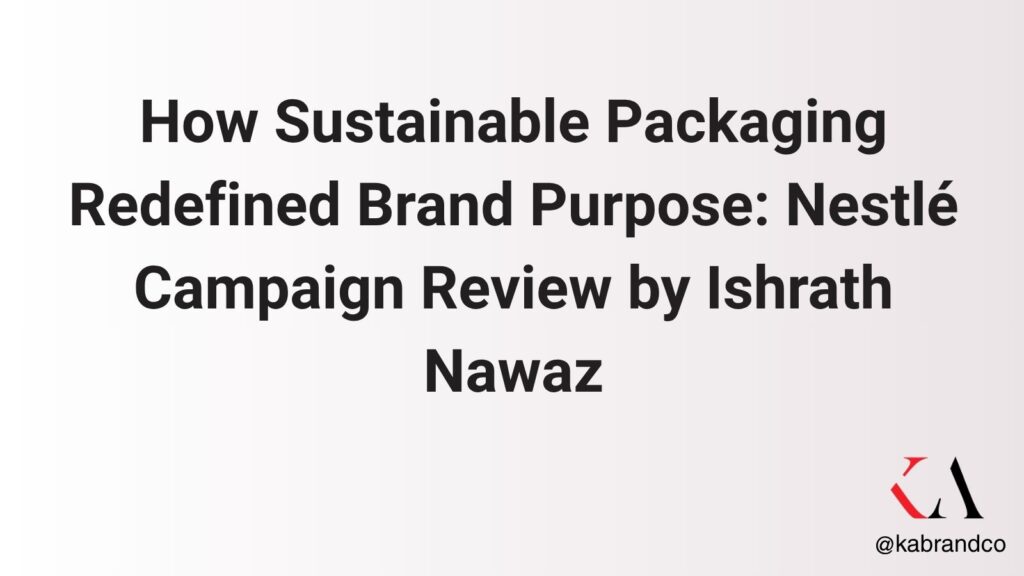How Sustainable Packaging Redefined Brand Purpose: Nestlé Campaign Review by Ishrath Nawaz

A New Era of Purpose-Driven Branding
In today’s era of conscious consumption, brands can no longer thrive on product quality alone—they need purpose. The Nestlé campaign review by Ishrath Nawaz shows exactly how a brand can merge innovation and responsibility to create real-world impact. Nestlé’s “Sustainable Packaging” initiative wasn’t just another marketing push—it was a genuine move to combat one of the planet’s biggest challenges: plastic waste.
Through this campaign, Nestlé demonstrated how forward-thinking marketing can drive both environmental change and business growth. Instead of telling customers to care, Nestlé showed that it does.
Turning Cheese Waste into Change
The heart of this campaign lies in purpose-driven innovation. According to the Nestlé campaign analysis by Ishrath Nawaz, the company turned waste from its cheese production process into biodegradable packaging. This move not only reduced waste but also minimized the brand’s carbon footprint—an idea both practical and visionary.
By reimagining waste as a resource, Nestlé tackled two global problems at once: food industry waste and single-use plastics. It’s a perfect example of circular economy thinking, where sustainability drives creativity rather than limiting it.
From Marketing to Meaning
What makes this campaign remarkable is how seamlessly it aligns with Nestlé’s broader brand purpose. In this Nestlé advertising campaign review, Ishrath Nawaz highlights how the brand didn’t just “say” it cared about the planet—it engineered that care into its operations.
Nestlé’s approach wasn’t performative; it was proactive. The brand positioned itself as a leader in sustainable innovation—showing that profitability and purpose can coexist. This shift turned Nestlé from a food giant into a sustainability pioneer, winning both credibility and consumer trust.
Sustainability as a Brand Differentiator
In a market crowded with eco-claims, authenticity is everything. The Nestlé campaign review by Ishrath Nawaz underlines that this campaign succeeded because it didn’t rely on buzzwords—it showcased real impact.
By transforming cheese waste into packaging material, Nestlé not only saved resources but also communicated a story that connected emotionally with consumers. This tangible proof of innovation set the company apart from competitors still relying on generic greenwashing tactics.
Such differentiation also boosted the brand’s reputation among younger audiences—those who demand transparency and authenticity from corporations.
Building Trust Through Tangible Action
According to Ishrath Nawaz’s Nestlé marketing insights, the real strength of this campaign lies in trust. Consumers are increasingly skeptical of sustainability claims, but Nestlé’s execution made the initiative believable. The brand embedded eco-consciousness into its very product DNA rather than treating it as a side project.
This commitment was reinforced by transparency—Nestlé openly shared data on production, impact, and waste reduction. As a result, customers didn’t just see a campaign; they saw a brand that genuinely practices what it preaches.
Cost-Effective Innovation That Scales
One of the most striking outcomes of this initiative was its efficiency. The Nestlé campaign review by Kabrand Consulting notes that transforming waste into packaging wasn’t just sustainable—it was cost-effective.
Instead of relying on expensive new materials, Nestlé leveraged what it already had. This approach lowered production costs while elevating brand value—a rare win-win scenario in modern marketing. It’s proof that sustainability can drive profitability when integrated thoughtfully.
The Human Side of Sustainability
Beyond the technical innovation, the Nestlé brand strategy review reveals something deeper—the emotional connection. Consumers today want to support brands that share their values, and Nestlé tapped into that sentiment. The brand’s decision to act on environmental responsibility gave people a reason to feel good about their purchase decisions.
By addressing a shared global concern, Nestlé turned everyday shopping into an act of contribution. That’s not just smart marketing—it’s meaningful storytelling.
What Marketers Can Learn
As Ishrath Nawaz reviews the Nestlé campaign, one key insight stands out: purpose is the new power move in branding. When a company aligns its mission with its actions, it doesn’t just sell products—it builds long-term emotional equity.
Marketers can take away a crucial lesson from this Nestlé campaign breakdown—don’t chase trends; create change. When innovation meets intention, the results can transform both the market and the mindset of consumers.
Final Thoughts: The Power of Purpose-Driven Strategy
The Nestlé campaign review by Ishrath Nawaz proves that great marketing isn’t about louder messaging—it’s about deeper meaning. By turning waste into opportunity, Nestlé demonstrated that environmental responsibility can be both scalable and profitable.
This initiative not only redefined how consumers see the brand but also set a new standard for purpose-driven innovation across industries. As sustainability becomes the heartbeat of modern branding, Nestlé’s campaign stands as a blueprint for others to follow.